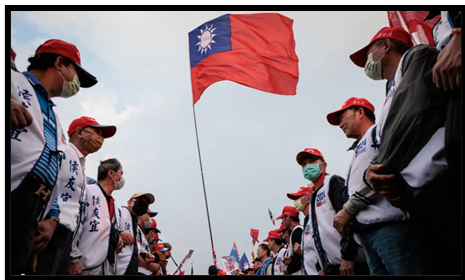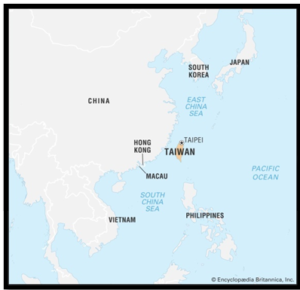HOW TO TRAIN OUR SIGHTS ON THE DRAGON
Syllabus:
GS 2:
- Bilateral, regional and global groupings and agreements involving India and/or affecting India’s interests.
Focus:
- Recent elections in Taiwan
Source:- MSSP
Recent Taiwanese Elections: A Dual Outcome
- DPP’s Presidential Triumph: The Democratic Progressive Party (DPP) secured the presidency with William Lai at the helm, underscoring the party’s favorable stance towards the West and its vision for Taiwan’s future.
- Legislative Challenges: Despite their presidential win, the DPP lost its legislative majority. The pro-China Kuomintang (KMT) and Taiwan People’s Party (TPP) gained significant seats, necessitating their cooperation for legislative processes, creating a hung parliament scenario.
- Implications of Mixed Results: The contrasting outcomes in the presidential and legislative elections indicate a divided political landscape, with potential challenges in policy-making and governance.
- Strategic and Ideological Divide: The election results reflect Taiwan’s internal ideological divide regarding its relationship with China and the West, complicating its domestic and international politics.
Taiwan’s Strategic and Economic Significance
- Geographic Importance: Situated in the Indo-Pacific region, Taiwan’s strategic location plays a pivotal role in regional trade dynamics, serving as a crucial link between China, Japan, and the Philippines.
- Population and Size: Despite its relatively small geographical area, Taiwan is densely populated, home to approximately 24 million people, highlighting its significant human resource potential.
- Global Semiconductor Leader: Taiwan dominates the global semiconductor industry, producing over 60% of the world’s supply, critical for various sectors including technology, automotive, and healthcare.
- “Silicon Shield” Concept: Taiwan’s semiconductor dominance acts as a “Silicon Shield,” indirectly protecting it from aggressive actions by China due to the global economic repercussions such a move would entail.
Historical Context and Ideological Clash Between China and Taiwan
- Colonial and Historical Influences: Taiwan’s history is marked by settlement and colonization, from Aboriginal Austronesian inhabitants to Han Chinese settlers, and control by the Dutch, Spanish, and Japanese, leading to a rich cultural tapestry.
- Sino-Japanese War to WWII: Taiwan’s transition from Qing dynasty control to Japanese colonization, followed by its return to China post-WWII, sets the stage for the complex China-Taiwan relations.
- Civil War and Two Chinas: The outcome of the Chinese Civil War led to the establishment of two separate entities: the People’s Republic of China (mainland) and the Republic of China (Taiwan), each claiming legitimacy over the other’s territory.
- Ideological Divisions: The DPP’s push for Taiwanese independence and international recognition contrasts with the KMT’s goal for reunification with China, reflecting deep ideological divides within Taiwan.
Defense, Diplomacy, and International Relations
- Taiwan’s Defense Capabilities: The island’s modern military and strategic defenses are crucial for its self-preservation amidst potential threats, particularly from China.
- Strategic Partnerships: Taiwan’s engagement with countries facing similar territorial challenges from China is vital for forming a collective front against expansionist policies.
- India-Taiwan Economic Cooperation: Enhancing trade and technological partnerships, especially in semiconductors, is a strategic move for India and Taiwan to counterbalance China’s regional influence.
- Global Strategic Interest: Taiwan’s situation is a litmus test for Indo-Pacific interests, with its sovereignty and defense capabilities drawing international attention, especially from the United States and its allies.
| India-Taiwan Relations:
· India adheres to the “One-China” policy, not recognizing Taiwan as a separate sovereign state. · Despite this, India and Taiwan have strong economic and people-to-people ties. · The need for a recalibrated approach towards Taiwan has been recognized since 2019, especially due to deteriorating India-China relations. · Bilateral trade grew from US $1.19 billion in 2001 to US $8.45 billion in 2022. · Taiwanese investment in India is significant, especially in electronics, IT, and manufacturing, driving technology transfer and industrial development. · There are active educational and cultural exchanges, with Indian students studying in Taiwan and vice versa, enhancing mutual understanding. · A 2007 MOU has led to 115 projects and 25 seminars in agriculture, healthcare, and disaster management. · Formal diplomatic ties are absent, but Taiwan prioritizes India in its New Southbound Policy, aiming for enhanced trade and cooperation. · Both countries view China as a strategic challenge and are keen on strengthening their partnership. |
Source:
https://epaper.newindianexpress.com/
Mains Practice Question:
“Discuss the implications of the recent Taiwanese elections for cross-strait relations between Taiwan and China. Evaluate how the mixed electoral outcomes reflect on Taiwan’s internal political dynamics and its strategic position in the Indo-Pacific region. Analyze the role of major global powers in shaping the future of Taiwan-China relations.”





